#flora fauna indonesia
Text
Inilah tanaman hias Aglonema Hot Lady Flaming yang konon diklaim sebagai yang terbaik di pasaran saat ini.

Tanaman hias yang cantik ini mempunyai warna daun cerah dengan tulang daun berwarna merah. Aglonema Hot Lady Flaming merupakan tanaman hias spesies populer, karena selain keindahan daunnya, juga mudah dalam perawatannya.
Tanaman ini telah dirawat selama waktu yang lama oleh ahli tukang kebun kami sehingga kualitasnya terjamin serta siap untuk dijadikan sebagai koleksi dalam hunian keluarga Anda.
Cocok ditempatkan di berbagai jenis ruangan seperti ruang tamu, kamar tidur atau bahkan kantor Anda. Dengan perawatan rutin seperti penyiraman dan penempatan di tempat teduh namun dapat memperoleh cahaya matahari secukupnya, maka Aglonema Hot Lady Flaming akan tumbuh dengan sehat dan cantik.

Dapatkan koleksi tanaman hias spesies populer dari kami untuk melengkapi dekorasi rumah atau tempat kerja Anda!
#plants#flowers#aglonema#tanamanhias#bungaaglonema#bunga#pecintabunga#tanamanindoor#handmade#pecintaaglonema#flora fauna indonesia
0 notes
Text
Ada jual burung hantu , monyet , beo dsb satwa eksotis @ pameran flora & fauna jakarta ❤️
https://youtu.be/lToRKJe_G20

#flona#flora#fauna#pameran flora fauna#lapangan banteng#youtube#youtuber#youtubeshorts#shorts#youtube shorts#wonderful indonesia#visit jakarta#wisata jakarta#jakarta
2 notes
·
View notes
Text
Bunga Melati Putih
Bunga Khas Indonesia | Bunga Tercantik
Bunga Melati Putih, Bunga ini dikenal juga dengan nama Jasminum Sambac. Bunga Melati Putih ini merupakan spesies bunga yang berasal dari Asia Selatan. Bunga ini tersebar di Hindustan, Indocina dan Kepulauan Melayu.
Bunga Melati Putih
Bunga Melati Putih ini merupakan salah satu dari Tiga Bunga Nasional Indonesia atau yang biasa disebut dengan Puspa Bangsa,…

View On WordPress
#aphrodisiac#bunga khas indonesia#bunga nasional#drugs#efficacy#fauna flora#flora fauna#holy#indonesia#infertility#infertility medicine#Jasmine flower#Jasmine flower morphology#medicinal ingredients#morfologi#morphology#national flower#natural aphrodisiac#prevent diabetes#puspa bangsa#savor#savour#vitality#vitality medicine
2 notes
·
View notes
Text

About one-third of all shark species are threatened—and tens of millions are killed each year by commercial fishing industries. Photograph By David Maupile/Laif/Redux
Sharks Are Still Being Killed At High Rates—Despite Bans On Finning
Shark fishing regulations, including bans on cutting off fins, increased tenfold since 2000. Yet a new study shows that deaths may have actually ticked up as new markets for shark meat emerge.
— By Tim Vernimmen | January 11, 2024
In 2019 at least 79 million sharks died in fisheries, and at least 25 million of those belonged to threatened species—numbers that have stayed steady or even risen in the past decade.
Compared to 10 years ago, fewer of those sharks died because people cut off their fins and threw them back into the sea—a practice known as finning that is now prohibited in about 70 percent of countries and overseas territories. But regulations that have reduced the frequency of finning have not saved shark lives, an international research team reports in the journal Science this week.
“If anything, global shark mortality has slightly increased,” says Boris Worm, a marine ecologist at Dalhousie University in Canada. Now most sharks are landed whole, and a growing demand for shark products has driven fisheries to continue catching the animals.
Worm and seven colleagues spent the past three years collecting data on shark mortality and fishery regulations. “This was really a challenge,” he says, “as shark fisheries are notoriously underreported. We compiled everything we could find, from catch numbers to data from observers on boats in international waters to estimates of coastal fishing that include recreational, artisanal, and even illegal fishing.”

Employees of the Kowalski fishing industry in Santa Catarina, Brazil, wash sharks recently caught in ocean fishing. Photograph By Victor MoriyamaFor National Geographic
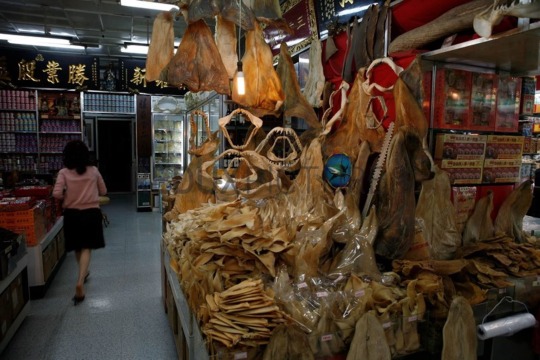
A counter in a Chinese medicine shop in Taipei sells shark fins. Photograph By Michael Wolf Estate/Laif/Redux
The global analysis reveals that even though there has been a tenfold increase in regulations on shark fishing and finning, mortality in the past decade remained more or less the same, with estimates of 76 million dead sharks due to fishing in 2012 and at least 80 million in 2018. Given that not all catches are reported in sufficient detail and some aren’t recorded at all, the researchers say, the number of deaths is likely to be significantly higher.
A Shark 🦈 Market
Marine ecologist Nicholas Dulvy of Simon Fraser University in Canada, who has not involved in the study, points out finning regulations did help “to ensure many catches could be identified to the species level, which is necessary for catch and trade limits” and also aids research. “Regulation of international trade has now begun, with the protection of over 100 shark species under the Convention on International Trade in Endangered Species of Wild Fauna and Flora,” he says.
While these trade regulations appear to have led to fewer sharks getting killed in international fisheries, coastal fisheries have started catching more sharks.
To try to understand why that might be, the researchers interviewed 22 experts including scientists, conservationists, and people working in fisheries or companies that process shark products. “They’ve told us that existing markets for shark products have expanded,” says marine conservation scientist Laurenne Schiller of Carleton University in Canada, a co-author of the study. “Which may be due in part to the increased availability of sharks resulting from anti-finning regulations.”
Shark meat, even from endangered sharks, is increasingly found in a variety of food products, and not just in still-popular shark fin soup. Shark is also often used in fish and chips, in ceviche, or as a fraudulent alternative for swordfish.
In addition, shark cartilage and liver oil are common ingredients in the medical and cosmetics industries. “Many beauty products contain squalene,” Schiller says, “which usually, but not necessarily, derives from sharks. So it’s good to look for products that use plant-based alternatives instead.”
The researchers say that that to save sharks, anti-finning laws clearly do not suffice, and there need to be more extensive fishing regulations.
“There are 29 countries and overseas territories that have already prohibited shark fishing in their waters,” says Worm. “The Bahamas, for example, have discovered that sharks were worth much more as a dive attraction for the ecotourism industry, which is booming. On average, we see such prohibitions are the only tool that consistently reduced mortality, so we would encourage that.”

Fishermen go out fishing sharks in Cananeia, a coastal town in the state of São Paulo, Brazil. Restrictions on species allowed for fishing have led many local fishermen to specialize in other fish and crustaceans such as shrimp and sea bass. Photograph By Victor MoriyamaFor National Geographic
Gillnets Kill
In places where people depend on fisheries for their livelihoods or sustenance, bans may not be appropriate, but keeping fisheries at sustainable levels is crucial to maintaining wild populations.
“This includes, of course, science-based catch limits for sharks,” says Schiller. “But many interviewees also told us about the dangers of unselective fishing gears, like gillnets.” These walls of netting that hang vertically in the water column are designed to catch fish by their gills, and they tend to entangle every animal that is too large to fit through the mesh. “Our own analyses show they are commonly used in the places we identify as mortality hotspots. So phasing them out and encouraging more selective practices in places like Indonesia, Brazil, Mauritania, or Mexico could have a big impact,” Schiller says.
“We know that shark populations are under enormous pressure from fishing throughout much of the world’s oceans,” says marine biologist Colin Simpfendorfer of James Cook University in Australia, who was not involved in the study, “and the data presented in this new paper add further evidence.”
While finning regulations have not led to decreased shark deaths, Simpfendorfer points out they weren’t designed to reduce catches, but to prevent suffering and the waste of sharks being killed for their fins alone.
Without increased efforts to protect sharks, at least one in three species will face the threat of extinction, and many more are suffering population declines.
“I have many colleagues who are oceanographers, and they tell me that in the 70s and 80s, there were always sharks following the vessel because of the kitchen scraps they threw overboard—typically oceanic whitetips, a formerly very abundant species that is now endangered and hardly ever seen. I’ve never seen one in my life,” says Worm. “That’s when you get that sinking feeling that something is really wrong with the way we’re treating them. We should fix that, and we can.”
#Animal#Wild Watch#The National Geographic Society#National Geographic#Killing of Sharks 🦈 🦈 🦈#Tim Vernimmen#Brazil 🇧🇷#China 🇨🇳#Dalhousie University | Canada 🍁 🇨🇦#Boris Worm#Nicholas Dulvy | Simon Fraser University | Canada 🇨🇦 🍁#Scientist Laurenne Schiller | Carleton University | Canada 🇨🇦 🍁#Wild Fauna and Flora#A Shark 🦈 Market#Bahamas 🇧🇸#Indonesia 🇮🇩 | Brazil 🇧🇷 | Mauritania 🇲🇷 | Mexico 🇲🇽
1 note
·
View note
Note
your post about potatoes in fantasy worlds made me base my primary fantasy continent off sudamérica so i could use fantasy versions of andean and amazonian fauna/flora. I'm still trying to figure out how to change the geography enough to have the big desert i want in the right area(andes get an offshoot that encircles a rain shadow desert in the central north is the best idea i have) but actually being forced to consider how native wildlife works and needing to create trade routes if i wanted imported crops was fun. i was also trying to figure out why the southern hemisphere has more hot climates than the north and something said it's because the south on earth has less landmass so i think having the northern hemisphere above it be mostly tropical works if I have mostly archipelagos? also every time i see a european based fantasy have potatoes or tomatoes i shake my head and scowl.
The reason why the Southern Hemisphere seems to have more hot climates is indeed simply because the continental parts don't spread that far South to actually cold southern latitudes. The only place that really sticks that far south to have a truly cold climate is the Patagonia. And of course, Antarctica, which by coinicidence, basically surrounds the South Pole.
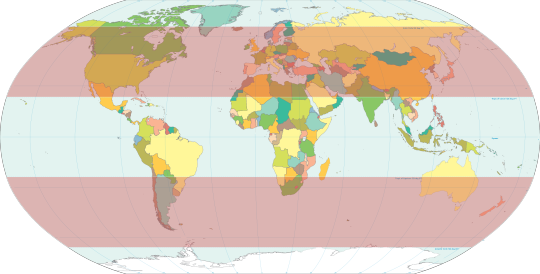
Here is a map of "temperate" latitudes, or rather, latitudes between the tropics and the polar circles (as someone who lives here, or indeed an Australian can tell you, many places there are not "temperate" at all but more on that below). What is important here is that the southern hemisphere has less places closer to the pole, except, again, Antarctica, while the northern hemisphere has lots of land near the poles. This is why we don't have our equivalents of say, Siberia, for example. The closest thing is again, Patagonia. Honestly an underused place for worldbuilding, with the steppe, the glaciers, the temperate rainforests, and the recently extinct megafauna, but I digress.
You could in fact have a tropical "north" if you keep most of the northern hemisphere's landmasses near the equator (here I'm picturing some kind of big Indonesia or Caribbean, an area where tectonic plates collide and there's lots of volcanic islands and lands), and you could place a big continent in the South to make it a cold South. Interesting reversal on the cold North/warm South of most settings.
This would bring some interesting effects, though. Placing a big landmass on any pole (not a small one like Antarctica) would lead to glaciation, as land is "colder" or rather less moderated by ocean (more on that later) and glaciers grow, and glaciers and arid land have greater albedo, reflectivity, that is, and so they reflect more sunlight, thus those place become colder, and the glaciers keep growing, and so on, until there is an ice-age. I don't have the link where I read it with me, but I recall that continents shifting to polar latitudes might have triggered ice-ages in Earth's past.
Deserts are very tricky to place. The standard worldbuilding recommendation is that the interior of the continents are drier as you get away from the sea, and that mountain chains and high terrain serves as rainshadows that stop rain from the sea. However, there is a lot more to it. A LOT more.
You can find deserts even next to oceans, in the so-called "horse latitudes", the meeting points of the Hadley Cells that circulate air from the Equator to the subtropics and beyond. The details are a bit technical, but what this means basically is that they create jet streams of circulating air at 30° South and North, keeping the climate sunny, warm and dry. This is indeed where many of the world's coastal deserts are: Atacama, Kalahari, and of course, Australia.
Meanwhile, in the equatorial zone, the "trade winds" (because they have regular wind patterns that have historical formed major sea trade routes, worldbuilding hint!) converge in the Equator, forming rainy areas... but not quite that simple.
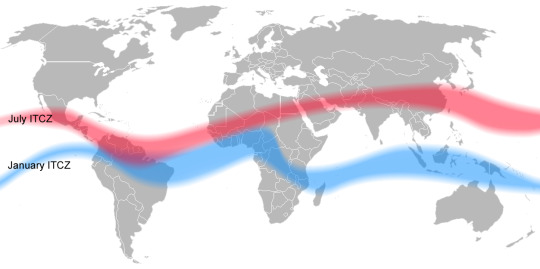
The Intertropical Convergence Zone, where these winds meet, ocsilates during the year, creating monsoons, but as always, there are lots of factors involved. In particular, given our real life scenario of rapid climate change and global warming, a warmer temperature means more intense ocsilations. This makes monsoon events sharper (more droughts and floods in those regions) and more strong La Niña/El Niño events, which are their own thing, influenced by the Pacific which is a huge factor in global climate.
And this brings me to ocean currents. Usually, being close to the ocean moderates the climate, making it more rainy and warm, or at least stable. However, if the surrounding sea is cool, it means less evaporation and less rainfall, especially if it's influenced by cool polar currents (this is the case of eastern Patagonia, for example, with the cold Malvinas Current). The opposite is the case in, for example, Europe, where the warm gulf stream moderates climate, making it warmer and rainer compared to the same latitudes in the US and Canada. I'll admit I'm not very well informed on how ocean currents work, but the depth and salinity of the ocean have much to do with it. What basically happens is that dense salty water sinks and and this works as a "conveyor belt" for warm less dense surface water to flow over it and over great distances. These currents are slow, but since the ocean is so massive, they move extensive amounts of heat across the world. I will admit defeat here and just say I don't wholly understand how it works, but I can tell you this; if your world has a less salty ocean, your currents will be less strong, which means that the differences of temperature between the poles and the tropics will be sharper as there are no strong currents to overall moderate temperature. If this is all too complex for you as it is to me, the quick cheat is just looking at this map: warm water flows from the equator, and cold water flows from the poles, and they create "gyres" around the oceans and the Equator, and cold currents contribute to colder and drier climates (note the Canary, Benguela and Peru currents, the Malvinas current is not shown for some reason...)
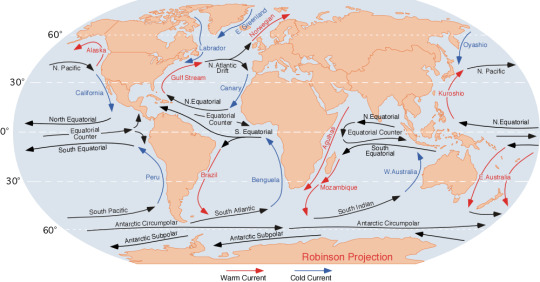
Did I forget something? Oh, yes. A colder climate of course, means less rainfall, because there is less evaporation and there is much water "trapped" in glaciers and snow. Which seems to be the case during the last ice ages. Rainforests and forests in general retreated as deserts expanded. In fact, the few forests that remained served as refugiums for species that only expanded again once the ice age was over. Some especulate that this might meant a 'weakening' of megafauna, as they were trapped in those refuges with lots of interbreeding and weakened populations when humans arrived on the scene. Here is a very interesting map:
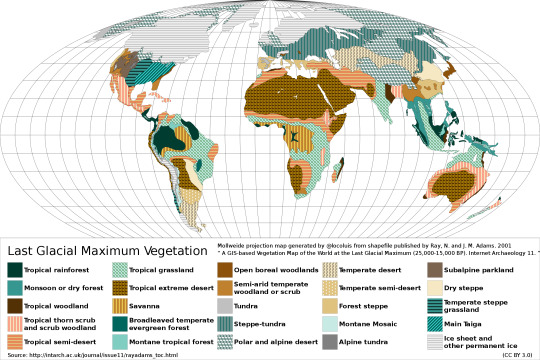
Now, there are some contradictions here and there, some researchers have said that the climate wasn't that dry and while I'm not an expert I tend to agree, many parts that are "extreme desert" there might be scrubland instead. But overall, it seems that colder times bring drier times too.
I'm still not done, but I'm almost done! According to the Biotic Pump theory, forests might also influence the climate and rainfall in a big way, basically, evapotranspiration (plants sweat, a lot, 90% of water through a plant evaporates to the atmosphere) in forests might actually create by itself the rainy environment where forests thrive, so for example, the Amazon is a rainforest BECAUSE of the forest there. I think with the increasing droughts here in South America we're seeing that theory proven in practice, as deforestation of the Mata Atlantica, the Chaco and the Amazon is causing less rainfall in the centre of the continent. Forests and plants also have a cooling effect, since they fix carbon dioxide, and also a bit of a warming effect, since they have darker albedo and so absorb more sunlight. I'm going to be very lazy and instead of reading a thousand papers say that they overall have a "moderating" effect.
Well, I could go on and on but I think I've already written way too much, so I'll leave you this to munch on a bit. It might seem like a lot, but when in doubt, you can always "eyeball" it by comparing real regions of Earth, and it will help you to create more interesting world than the omnipresent "spring-summer-fall-winter" temperate standard in so many settings.
If you have any questions, feel free to ask! Oh, and also, if you found this helpful or interesting, I would appreciate a tip to my ko-fi!
164 notes
·
View notes
Text



Puteri Indonesia Kalimantan Timur 2023 Regional Costume: WONDERLAND EAST KALIMANTAN
Costume inspired by Heaven in east Borneo to become a hidden paradise on the island of Kalimantan. the bird appear in front to be a symbol of the love of the original Dayak tribe of East Kalimantan who is able to sustain the beauty of the sea, heaven of the earth. The back of the costume was inspired by the beauty of the undersea paradise of the virgin islands that store the marine biome that is very beautiful with its blue water, and decorated with the weave of the dayak kaltim tribe called the ulap doyo weave looks beautiful after the beauty of the original forest of kalimantan that store flora and fauna that is very protected and almost extinct, among them Eggang bird, orangutan, and incense orchids as well as black orchids which is a rare characteristic of Kalimantan that is hard to find its existence Capital Development with the concept of sustainability forest city is expected to be able to maintain the beauty and the richness of nature which becomes the hidden sea paradise in East Kalimantan Eta Continent The beauty of East Kalimantan never ceases to amaze everyone. From your estuaries to your mountains, your charm and allure are simply form of paradise.
Translated via google translate
37 notes
·
View notes
Text
Far Cry 3's Rook Islands - how based on Indonesia is it actually is
according to an Indonesian who is not exactly qualified to write this post but by god will i make that everyone else's problem. Long post under the cut in case you'd like to know the fun facts and insights about the game and Rook and how much they got right and wrong.
Here's what I will discuss:
Locations, Flora & Fauna
The Rakyat and what they preach and practice
Citra, Dennis and Vaas
I would like to preface by saying Indonesia is a big ass archipelago, literally the biggest archipelagic state in the world, and we have many cultures, sub-languages, and various indigenous tribes of which I'm not part of. So there could be a possibility that the FC3 game devs were basing Rook especially the Rakyat on certain tribes I'm not familiar with or with an actual cultural rep who knows more than I do, but somehow I doubt that too, considering how they seem to just base Rook vaguely on various Polynesian areas.
1. Locations, Flora & Fauna
The Rook Islands page in the Far Cry 3 Wiki does a great job of explaining this in more depth than I do, but to TL;DR it: the flora & fauna in Rook makes it seem like Rook's most likely in the eastern side of Indonesia (sharing the same fauna and flora as Papua New Guinea and Australia). This is especially evident since Rook has komodo dragons and they're only available in Nusa Tenggara Timur.
However, the vastly different animals in the North and South Islands of Rook indicates the possibility of Rook running through the Wallace Line, which irl happens between Bali and Lombok, two very close islands which have vastly different faunas.
So actually to squash down the locations into two tiny islands and grab all the crazy animals into two distinct parts like this actually happens irl, which is cool!

I got nothing much to add about plants cus they all seem to be pretty straightforward and all are available in Indonesia from what I see... with the exception that I previously had believed that the white plant that Jason can pick to craft immunity effects are jasmines, but it seems that officially they're tiares which are more commonly known as being used as leis by the Polynesian people. Either way, both Jasmines and Tiares are small, worn traditionally by women, smells nice and have some spooky connotations, so same difference to me :^)
The only location in-game with an Indonesian name is Beras Town. Beras means 'uncooked rice', so there's a little fun fact to note since when you get there the first time to see Hoyt shooting at the natives it was fittingly in a rice paddy field.
2. The Rakyat and what they preach and practice
The Rakyat is a dead giveaway that Rook is based on Indonesia or Malaysia. Rakyat means 'people' in both languages, and is pronounced correctly in-game. However, most of the Rakyat weren't speaking Indonesian and spoke with a New Zealand accent so are they like. Samoan? Maori?? God knows.
Indonesia has certain tribes who have tattooing as part of their history and culture, but the tatau seems to be based more on the Samoan tatau, at least from the name itself. Tattoos are called tato in Indonesian and not tatau. The design is also not like any known designs from tribes that have tattooing culture in Indonesia. With how Dennis explains each animal on Jason's tatau had meaning in the Rakyat's history for warriors, it seems like the entire thing was a creative liberty.
Other than the tataus, there's not much we know of about The Rakyat other than they're natives of the island. There's a side mission where you have to spy on a cheating husband, this one stuck out to me for a couple reasons. One being it's funny as hell, and also because the name of the guy the husband is cheating with is Jalak. Jalak is the Indonesian name for a Starling, there's a specific sub-species of the bird that is endemic to Bali, Indonesia. It's extra-funny if it's implied that the man the husband is cheating with is named after a bird because the word bird in Indonesia (burung) is a euphemism for dick.

Another side mission also has a minor character you have to find called 'Senin' which was pronounced wrong but it's an Indonesian word that means 'Monday'.
Those are all I remember, I'll edit if I remember more!
3. Citra, Dennis and Vaas
Citra - let's start with the most glaring thing. Citra is not supposed to be said with a 'S' sound but a 'Ch' sound. (if you go to google translate and type in Citra in Indonesia and listen to it, that's the right pronunciation). If they wanted to pronounce it like they did in-game, they should've just named her Sitra which would still sound pretty natural as an Indonesian name.
Other than her name pronunciation error, the name itself is actually pretty solid. Citra means image, like 'made in the image of god' kind of image. Considering she is the Rakyat's leader and is obsessed with cultivating an image of strength and traditional values, it's a fitting name.
Citra is also the only character to speak proper Bahasa Indonesia. She actually pronounces the words correctly and speaks clearly, which I was pleasantly surprised with! Just ignore the way the Indonesian is written in subtitles cus they are completely wrong. She only says a few lines so I'll discuss them here:
Senapan ke bawah - said when Jason first shows up with Dennis at her temple and she asks her men to stand down. Translates to 'Lower your guns.'
Berikan saya herbal - said when she asks for the first potion that Jason has to drink to get the vision that led him to hallucinate where to find Willis. Translates to: 'Give me the potion/herbs'.
Cinta untuk anak-anak kami - you can miss this if you didn't pick her ending. This is the only correctly subtitled Indonesian line, and it translates to 'love for our children'. Not child. Children. Plural. Miss ma'am... what in the everliving fuck are you trying to do hoping to have children with a guy who's shooting blanks at this point and who you proceed to kill immediately after? Let's move on.
Dennis speaks Bahasa Melayu, which is quite interesting to note, considering he is a foreigner who tries very hard to fit in. Bahasa Melayu and Bahasa Indonesia are very similar to each other, hence why we can understand each other, but there is still a distinct difference between them. Since we're overanalyzing, it could be said that Dennis and Citra has never been 100% on the same page with how they speak slightly different languages.
Vaas never once speaks Bahasa Indonesia or Melayu, which considering how he has thrown away his Rakyat roots, makes some sense. And I love Michael Mando but I think he would definitely butcher the language lmao so it's great that they didn't make him say any native lines. Vaas is also not an Indonesian name, though we do have vas as a word, since vaas is Dutch for 'vase' and we picked up a few words when Netherlands colonized Indonesia. but i doubt they used the word vase for a villain name but hell, who knows. If we wanna get funky I guess we could say that Vaas was always colonized/under someone's control even down to his name.
Conclusion
Far Cry 3's Rook personally for me didn't do a good job at being Indonesian enough, from how villages look, to location names, to little things like the lack of food stalls that you would 100% be able to find if you just walk down the road in any location here. Though to be fair, it was 2012 and as such, a different time with different standards that they have since then set higher for themselves. Ubisoft did a much better job at adapting Kyrat into a believable country that was based off Nepal with rich world-building from NPC notes, locations in map, to the little items you can loot from the enemies that included Bagh-chal pieces! FC5 was also very true to Montana from what I'm led to believe from the countless praises in Reddit, and FC6 had a lot of great representation too.
At the end of the day, FC3's a great game with a solid map based vaguely off a location I just happen to be familiar with, and that is still pretty fucking cool.
27 notes
·
View notes
Text
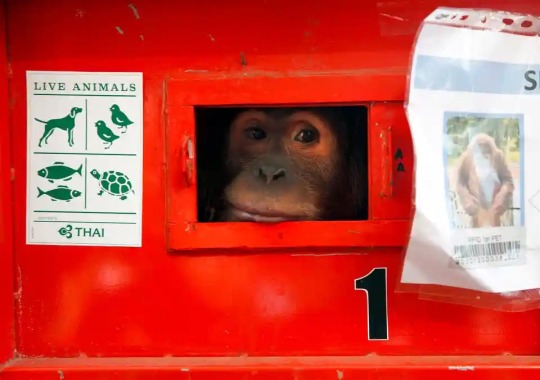
Samut Prakan, Thailand
Shizuka, a seven-year-old female, looks out from a cage during a repatriation ceremony of confiscated smuggled orangutans from Thailand to Indonesia, at the cargo area of Suvarnabhumi airport. Thailand returned three orangutans that were rescued after being smuggled from Indonesia, as part of the country’s anti-trafficking initiative under the Convention on International Trade in Endangered Species of Wild Fauna and Flora
Photograph: Rungroj Yongrit/EPA
4 notes
·
View notes
Note
it's post-apocalyptic right? are there flora/fauna that are extant irl that are extinct at the beginning of se?
it is indeed post apocalyptic!!! 3 apocalyptic world ending events in a row
a huge number of large terrestrial animals have actually gone extinct! - or are at least functionally extinct. animals such as elephants, tigers, horses, most bovines, etc- they no longer survive well in the wild or without human help and at this point in time (2005) it’s mostly due to Martians, who like to eat everything they can sink their teeth into (as well as. “get with” whatever they can sink their teeth into so a lot of animals in the wild can actually be feral chimera). fish are mostly fine btw, just some slight radiation exposure 🌝 Martians don’t particularly like water so don’t really bother with the ocean
HOWEVER!!! there are animals that were FORMERLY extinct that have been brought back to life- mostly dinosaurs?? and ice age megafauna that millionaires keep in private zoos and stuff. it’s actually super rare that you’ll see any formerly extinct creatures out in the wild tho (except the ones in florida)
as for flora, plenty of plant life died in the initial nuclear winter after the war, then the supervolcano eruption. plants are mostly fine and were able to recover in africa, most of asia, indonesia, and south america. a vast majority of the dirt in north america is NOT arable and most foods (around 80%) are either synthetic or come from protein farms (they’re called mash or OMs depending on their content) but yeeeeeaaaah almost none of the food in SE is “real”. very fun
#kudzu responds#superglue#shattered earth#just know that everything is shit in se#mostly for north america and western europe tho tbh. everywhere else is getting by just fine
5 notes
·
View notes
Text
Hari pernikahan ku menjadi hari yang sama untuk kematianku. Karna hari itu, sebelum menjadi seorang suami aku harus membunuh seorang lajang didalam diriku.
Sebelum menjadi bertanggung jawab dan setia pada satu hati, harus dimatikan penyebab terjadi ketidak bertanggungjawab dan dirobohkan beberapa pintu hati selain satu yang tercinta diinginkan hati.
Dan kata guruku, "Menikah itu seperti memasukkan satu dunia ke dalam rumah."
Jadi, aku berharap, semoga rumahku cukup luas untuk memberi ruang pada dunia itu, dengan duka serta senang bergantian seiring musimnya, dengan aneka flora fauna liar dan ramah mengiringi langkahnya, dengan segala harapan dan doa yang mengangkasa.
Hingga tiba. Sang Ibu, tanah, mendekap erat. Menuju kekesejatian kelahiran dan kematian.
"Dan usia cinta lebih panjang dari percintaan."
Seperti dengan usia hidup jauh lebih panjang dari kehidupan.
Indonesia, Agustus 2023.
4 notes
·
View notes
Text
Aglonema Suksom Compacta
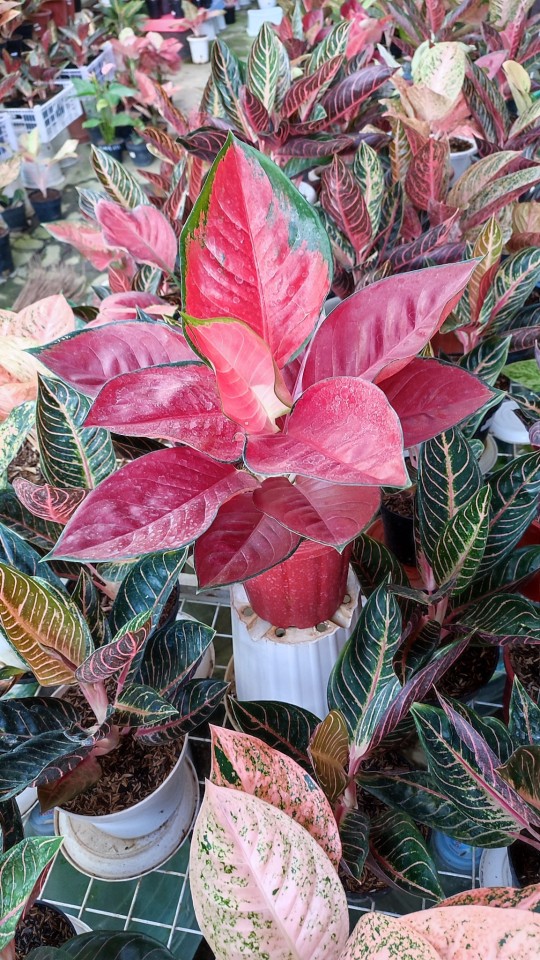
0 notes
Text
10 tumbuhan langka di Indonesia

Kekayaan Indonesia tidak perlu diraguan lagi. Baik dari flora dan fauna, Indonesia sangat kaya akan hal itu. Namun, seiring bertambahnya waktu keberadaan atau jumlah dari hewan atau tumbuhan yang ada di Indonesia semakin berkurang dan sedikit. Tentu jika berlangsung terus-menerus, bukan tidak mungkin suatu jenis flora atau fauna mengalami kepunahan. Di bawah ini sudah saya taruh suatu wacana yakni 10 tumbuhan langka di Indonesia yang semoga bermanfaat.
Baca selengkapnya :
2 notes
·
View notes
Text
Yaki
Monyet Wolai | Monyet hitam sulawesi | Macaca nigra | Kera Jambul
Yaki, merupakan salah satu satwa endemik dari negara Indonesia yang bisa anda temui di daerah sulawesi, Khususnya sulawesi utara. Perlu anda ketahui bahwa Yaki merupakan jenis monyet makaka terbesar di pulau sulawesi.
Yaki
Salah satu ciri khas dari monyet ini adalah warna seluruh tubuhnya yang hitam pekat dan mempunyai jambul…
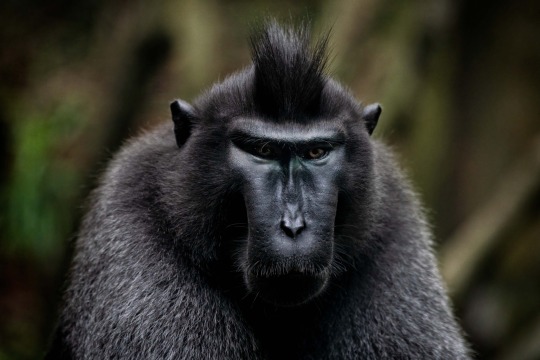
View On WordPress
#animal#black monkey#crested monkey#fauna flora#flora fauna#good trend#hewan endemik#indonesia#keep#macaca nigra#macaque monkey#monkey#monkeysurvey#morphology#morpologi#tend#wildlife#yaki
0 notes
Text
Dunia Saya Sempit
Mendengarkan cerita teman cukup banyak membuka wawasan baru, atau lebih tepatnya memperluas ekspektasi terhadap probabilitas kehidupan yang terjadi atau pula, mengekerdilkan wawasan dan eskpektasi hidup, yang saya ketahui sampai saat ini. Ya segalanya berjalan dua arah.
Waktunya mungkin singkat, tapi sejak waktu menjelang siang hari ini, mendengarkan obrolan Fahmi dan Sito terkait kehidupan masing masing, ditambah bumbu dari yang lain, memunculkan pertanyaan "iki sopo?" "kui ng ndi?" dan tentu "kok kowe isoh ngono, pie?" pertanyaan yang paling menjadi keresahan tulisan ini dibuat
Kehidupan galeh, memang saat ini, sangat bisa dibilang, gitu gitu aja, membosankan. Setelah dibandingkan kehidupan teman teman yang lain, atau lebih tepatnya, teman yang baru kembali bertemu setelah cukup lama. Dan ini baik. Dalam artian, bismillah masih banyak waktu, Indonesia masih luas, apalagi bumi dan luar angkasa. serta tentu berbagai macam flora dan fauna, berbagai macam pula aneka jenis manusia dan keberagamannya.
Semoga ya, dengan sisa waktu yang ada, hidup bisa jadi lebih berwarna.
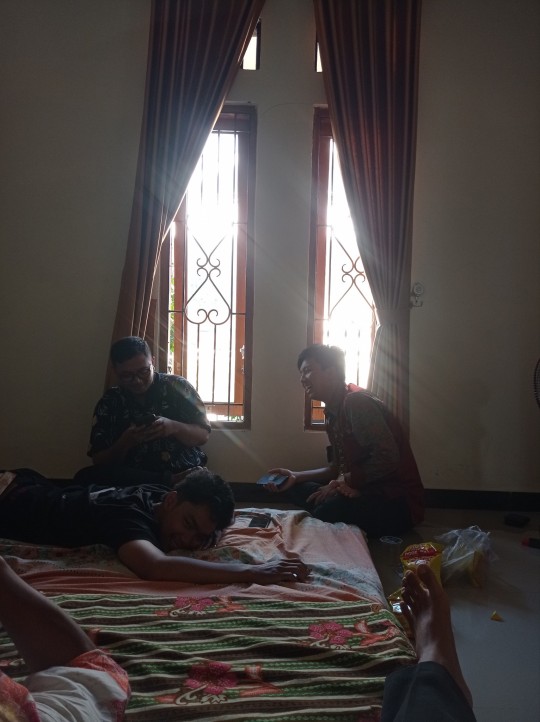
1 note
·
View note
Text
It may come as a surprise that sand is one of the world’s biggest traded commodities by volume (if not value). Of the nearly 59 billion tonnes of material mined every year, 68 to 85 per cent is sand and gravel. The world consumes more than 40 billion tonnes of sand a year – used for construction, land reclamation, shoreline development, and road-building – a rate far faster than the natural replenishment of the stuff by rivers or on beaches. Remarkably, the abundant sand of the Arabian deserts on the Peninsula is thought inappropriate for making concrete. Concrete mixing requires angular sand, which is either marine or riparian, mined from beaches or rivers. Desert sand, eroded by winds, is far too rounded and smooth.
As world cities hunger for construction and trade, sand mining has become a more visible ecological crisis. In 2014, the United Nations Environment Programme sounded the alarm about both legal and illegal sand mining. Quarrying sand from rivers has had such detrimental effects on riparian environments that many states have banned them. In Myanmar, the riverbed sand of most rivers has been shipped to Singapore to feed its hunger for land, leaving the rivers of Myanmar vulnerable to flooding and their banks exposed to erosion. Excavating sand from riverbeds can change the form of the beds and affect flows; it can stir up sediments, creating a watery storm of particles, altering biodiversity and water quality. It can catastrophically transform vegetation and water temperatures and the efficiency and safety of riverine infrastructures (dams and dykes, as well as bridges and crossings and embankments). It can accelerate the washing away of soil from riverside lands and damage the livelihoods of people who depend on the bounty of these lands and rivers. On beaches, it threatens coastal flora and fauna, accelerates shoreline erosion, reduces natural protection from sea storms and tsunamis, and undermines beachside infrastructures. Entire beaches in the Caribbean and Pacific have been stripped of their sand; entire sand atolls – for example, in Indonesia – have disappeared to feed this insatiable hunger for sand. Though fiercely contested, the transnational exploitation continues.
Laleh Khalili, Sinews of War and Trade: Shipping and Capitalism in the Arabian Peninsula (Verso, 2021), pp. 83–4.
5 notes
·
View notes
Text
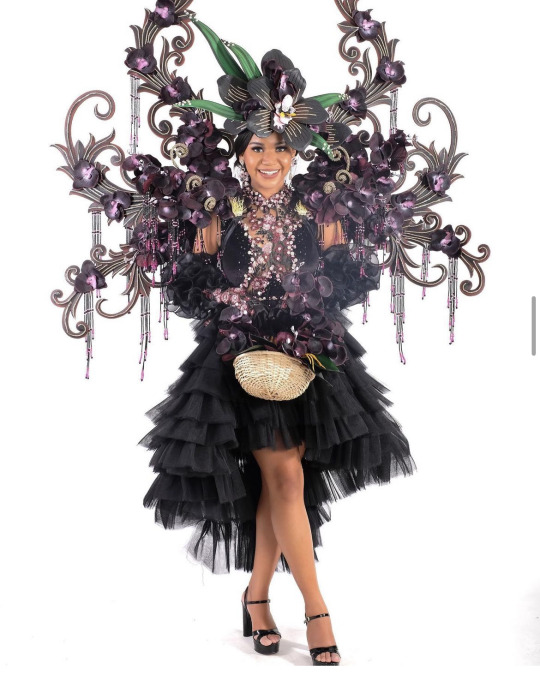

Puteri Indonesia Papua Barat 2 Regional Costume: "Bunga Anggrek Hitam Papua"
Papua, a land in the eastern tip of Indonesia that has a tremendous natural wealth ranging from mining, natural beauty, culture, flora, to fauna. One thing that may not be known much, Papua has one unique and rare plant that can only be found in Papua that is Papua Black Orchid. Papuan Black Orchid is an epiphytic plant with black legaments, buds and pink and purple adornments. The Papuan black Orchid is seen as a symbol of mystery, elegance, strength and sophistication.
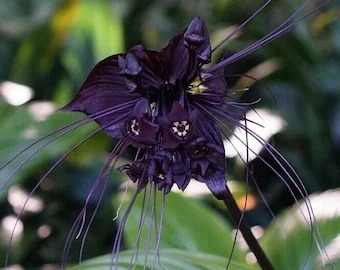
36 notes
·
View notes